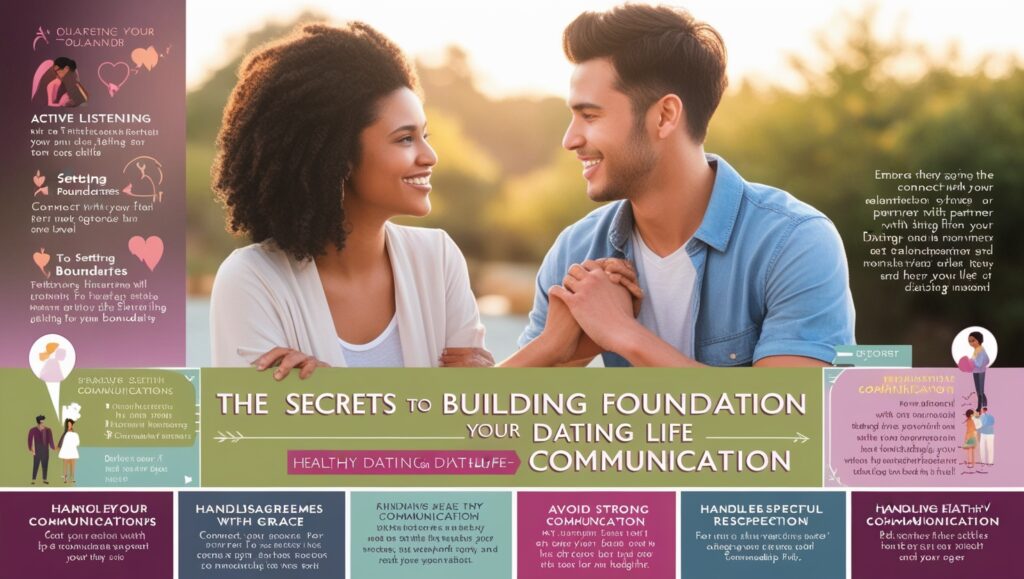Healthy Communication in Dating Need to Know
Healthy Communication in Dating can be the foundation of a thriving relationship—or the cause of its downfall. Healthy communication is more than just talking; it’s about connecting, understanding, and respecting each other’s thoughts, feelings, and boundaries. Here, we’ll break down the essentials of communicating in a way that builds trust, promotes mutual respect, and strengthens your relationship from the start
1. Start with Active Listening
Listening is the backbone of healthy communication. Active listening means being fully present when your partner speaks, resisting the urge to interrupt or jump to conclusions. Practice focusing entirely on what your date is saying, nodding along, or giving nonverbal cues to show you’re engaged. You may be surprised at how much easier it becomes to understand each other when you’re truly listening.
Tip: Instead of thinking about what you’ll say next, let your partner’s words sink in before responding. This helps avoid misinterpretation and ensures that each person feels genuinely heard.
2. Be Honest (But Kind)
Honesty is vital in any relationship, but so is kindness. Being transparent about your feelings and intentions prevents misunderstandings and helps both partners stay on the same page. If something is bothering you, communicate it gently but directly instead of letting it fester.
Example: Rather than saying, “You never make time for me,” try, “I feel a bit disconnected when we don’t spend time together. Can we plan something soon?
3. Express Your Needs and Boundaries Clearly
Healthy relationships require clear boundaries. Whether it’s about personal space, time commitments, or physical boundaries, setting them early on helps avoid uncomfortable situations. Don’t shy away from expressing what you need to feel respected and safe.
How to do it: Use “I” statements to express needs without sounding accusatory. For instance, “I need time to recharge after a long day,” instead of “You’re always demanding my attention.
4. Watch Your Body Language
Nonverbal cues—like eye contact, facial expressions, and body posture—can reveal more than words. Crossing arms, avoiding eye contact, or sighing heavily may send a message of disinterest or frustration. Being mindful of your body language when communicating can create an atmosphere of openness and warmth.
Practice Tip: Make eye contact, lean in slightly, and keep a relaxed posture to show engagement and interest. This kind of openness encourages your date to feel more connected and at ease.
5. Be Patient and Accept Imperfections
Good communication isn’t always immediate or flawless. Everyone makes mistakes, especially in new relationships. Practice patience and approach miscommunications with an open mind. Instead of overanalyzing or assuming the worst, seek clarity by asking questions when something feels unclear.
Example: If a text message seems off, consider asking, “Is everything okay? I noticed your response seemed a bit different than usual.” This keeps the focus on understanding instead of jumping to conclusions.
6. Share Openly About Your Intentions
Knowing where you both stand and what you want from the relationship is important, even if the topic feels heavy. If you’re seeking a committed relationship while they prefer casual dating, this is something to discuss openly. Clear intentions help avoid heartbreak and allow both partners to align expectations..
How to Start: Begin with, “I really enjoy spending time with you, and I want to be upfront about what I’m looking for. I’m interested in exploring a serious relationship. How do you feel about that?”
7. Don’t Be Afraid to Take a Break When Needed
If things get heated or feel overwhelming, it’s perfectly okay to take a step back and process your feelings. Taking a short break to cool off prevents reactive responses and allows you to come back to the conversation with a clearer perspective.
Try Saying: “I’m feeling a bit overwhelmed right now. Can we take a short break and come back to this conversation later?” This approach shows maturity and respect for each other’s emotional state.
8. Celebrate Vulnerability Together
Vulnerability is a beautiful part of building closeness. Sharing fears, dreams, and insecurities allows you to understand each other on a deeper level. While it might feel intimidating to open up, doing so often encourages your partner to be more open as well, laying the groundwork for emotional intimacy.
Ideas to Try: Share a story from your past, talk about your aspirations, or discuss a challenge you’re facing. This openness creates a sense of safety and authenticity between you.
9. Learn to Handle Disagreements Gracefully
Disagreements are a natural part of any relationship. What matters most is how you handle them. Avoid blaming language, and instead, focus on finding a solution together. Compromise is often the best path forward, as it allows both of you to feel valued and heard..
Phrase to Remember: “It’s not us versus each other; it’s us versus the problem.” This mindset can transform conflicts into opportunities for growth.
10. Practice Appreciation and Positivity
Positive reinforcement can go a long way in keeping communication healthy and uplifting. A simple “thank you” or “I appreciate you” shows that you value your partner and their efforts. Regularly expressing appreciation can create an environment of mutual respect and warmth, making challenging conversations easier to handle.
Daily Practice: Compliment each other, acknowledge small gestures, and celebrate your partner’s strengths. These little affirmations build a strong, positive connection.
Final Thoughts
Communication is the heart of any healthy relationship, and dating is the perfect time to start building these skills. Remember, it’s not about finding someone you never disagree with—it’s about finding someone you can navigate disagreements with respectfully. By practicing honesty, empathy, and patience, you create a foundation of trust and understanding that paves the way for a meaningful relationship.

